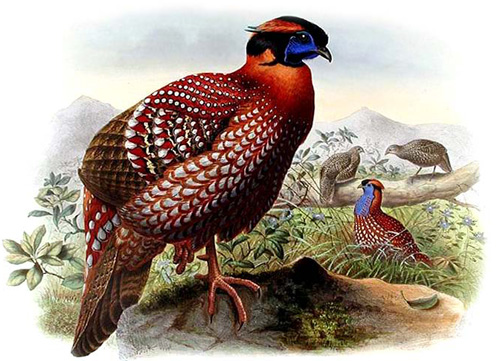Kingdom: Animalia Phylum: Chordata Class: Aves (Birds) Order: Galliformes Family: Phasianidae |
|
Temminck's Tragopan (Tragopan temminckii), also called Crimson-bellied Tragopan, is a local resident in higher altitudes of eastern Himalayas. Size: 64 cm (male). The Temminck's tragopan is on the endangered species list. Their habitat is being invaded by humans and their forests are being cut down. These birds are also hunted for their colorful feathers. Efforts are being made to breed these birds in captivity. Identification: The tragopans are horned pheasants with short bills and tail feathers that are shorter than wing length. The female Temminck's tragopan has feathers in a dull mixture of black, brown, and gray which they use as camouflage while the male tragopan is much more extravagant. The males have brownish red plumage that have ocelli underneath and large eyespots that are surrounded by black borders. Each individual feather is gray and has a striking red border. The tail is brown barred and stippled with black at the base turning to black at the tip. The male tragopan has blue skin on its face and a bib-like wattle on its throat. Distribution: The Temminck's tragopan can be found in eastern India, southern and central Asia, as well as central China. Unlike most of their pheasant relatives, the Temminck's tragopan prefers to nest in trees and can be found living at altitudes between 3,000 and 12,000 ft. Habits: Tragopans are very shy in the wild and usually hide in the trees among the foliage, although in captivity they can be tamed. They live singly or in pairs. Food: Tragopans feed on berries, seeds, leaves, buds, shoots, fruits, and insects.
Breeding: The Temminck's tragopan may take over someone else's
abandoned nest to lay their eggs or build a new one on a tree just a few feet
off the ground. When the female has found a suitable nest,
she will line it with leaves and twigs and lay 3-5 rather large eggs in it. She will
incubate the eggs for 28-30 days until they hatch. The chicks hatch out
large, strong, and with well developed wings. The new chicks develop
very quickly and are able to fly just days after hatching. |
| |
| Apodiformes | Bucerotiformes | Ciconiiformes | olumbiformes | Coraciiformes | Cuculiformes | ||
| Gruiformes | Passeriformes | Piciformes | Psittaciformes | Strigiformes | Trogoniformes | Turniciformes | Upupiformes |
All rights reserved. Copyright © 2005-2013 Birds and birding in India. Disclaimer website: Free Java Guide & Tutorials |








